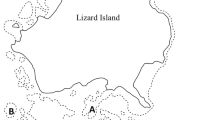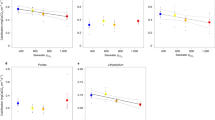Abstract
Ocean acidification is one of the key threats facing coral reef ecosystems, but there are few estimates of spatial and temporal variability in pH among reef habitats. The present study documents levels of spatial variability in pH among coral reef habitats (9 to 10), among locations separated by 100’s km of latitude and between east (Great Barrier Reef, GBR) and west (Ningaloo Reef) coasts of Australia. Differences were found in pH between inshore and offshore waters along Ningaloo Reef (means 8.45, 8.53, respectively). Replicate assessments here ranged from 8.22 to 8.64. On the GBR, the range of values over all habitats and replicates was 0.39 pH units (7.98 to 8.37). There were minor but significant differences of 0.05 pH units between 5 consecutive days for habitats on average. Highest pH was recorded in filamentous algal beds maintained by the damselfish Dischistodus perspicillatus. Lowest pH was found in water extracted from sand-dwelling goby holes. While there were marked changes in pH over a 48-h sampling period among 4 habitats at Lizard Island (GBR), there was little evidence of a diel trend. Understanding how pH varies at scales that are relevant to organisms that live on shallow coral reefs is crucial for the design and interpretation of experiments that test the effects on organisms of the changes in water chemistry predicted to affect oceans in the future.





Similar content being viewed by others
References
Bindoff NL, Willebrand J, Artale V, Cazenave A, Gregory J, Gulev S, Hanawa K, Le Quéré C, Levitus S, Nojiri Y, Shum CK, Talley LD, Unnikrishnan A (2007) Observations: oceanic climate change and sea level. In: Solomon S, Qin D, Manning M, Chen Z, Marquis M, Averyt KB, Tignor M, Miller HL (eds) Climate change 2007: the physical science basis. Contribution of working group I to the fourth assessment report of the intergovernmental panel on climate change. Cambridge University Press, Cambridge, pp 384–432
Caldeira K, Wickett ME (2003) Anthropogenic carbon and ocean pH. Nature 425:365
Doney SC, Fabry VJ, Feely RA, Kleypas JA (2009) Ocean acidification: the other CO2 problem. Ann Rev Mar Sci 1:169–192
Fabry VJ, Seibel BA, Feely RA, Orr JC (2008) Impacts of ocean acidification on marine fauna and ecosystem processes. ICES J Mar Sci 65:414–432
Fine M, Tchernov D (2007) Scleractinian coral species survive and recover from decalcification. Science 315:1811
Green A (1998) Spatio-temporal patterns of recruitment of labroid fishes (Pisces: Labridae and Scaridae) to damselfish territories. Environ Biol Fish 51:235–244
Guinotte JM, Fabry VJ (2008) Ocean acidification and its potential effects on marine ecosystems. Ann NY Acad Sci 1134:320–342
Hinga KR (2002) Effects of pH on coastal phytoplankton. Mar Ecol Prog Ser 238:281–300
Hoegh-Guldberg O, Mumby PJ, Hooten AJ, Steneck RS, Greenfield P, Gomez E, Harvell CD, Sale PF, Edwards AJ, Caldeira K, Knowlton N, Eakin CM, Iglesias-Prieto R, Muthiga N, Bradbury RH, Dubi A, Hatziolos ME (2007) Coral reefs under rapid climate change and ocean acidification. Science 318:1737–1742
Iglesias-Rodriguez MD, Halloran PR, Rickaby REM, Hall IR, Colmenero-Hidalgo E, Gittins JR, Green DRH, Tyrrell T, Gibbs SJ, von Dassow P, Rehm E, Armbrust EV, Boessenkool KP (2008) Phytoplankton calcification in a high-CO2 world. Science 320:336–340
Ishimatsu A, Kikkawa T, Hayashi M, Lee KS, Kita J (2004) Effects of CO2 on marine fish: larvae and adults. J Oceanogr 60:731–741
Kawahata H, Suzuki A, Goto K (1997) Coral reef ecosystems as a source of atmospheric CO2: evidence from pCO2 measurements of surface waters. Coral Reefs 16:261–266
Kleypas JA, Feely RA, Fabry VJ, Langdon C, Sabine CL, Robbins LL (2006) Impacts of Ocean Acidification on Coral Reefs and other marine calcifiers: a guide for future research, Report of a workshop held 18–20 April 2005, St. Petersburg, FL, sponsored by NSF, NOAA, and the US Geological Survey
Manzello DP, Kleypas JA, Budd DA, Eakin CM, Glynn PW, Langdon C (2008) Poorly cemented coral reefs of the eastern tropical Pacific: possible insights into reef development in a high-CO2 world. Proc Nat Acad Sci USA 105:10450–10455
Middelboe AL, Hansen PJ (2007) High pH in shallow-water macroalgal habitats. Mar Ecol Prog Ser 338:107–117
Munday PL, Jones GP, Sheaves M, Williams AJ, Goby G (2007) Vulnerability of fishes of the Great Barrier Reef to climate change. In: Johnson JE, Marshall PA (eds) Climate change, the Great Barrier Reef. Great Barrier Reef Marine Park Authority and Australian Grenhouse Office, Australia, pp 357–391
Munday PL, Jones GP, Pratchett MS, Williams AJ (2008) Climate change and the future for coral reef fishes. Fish Fish 9:261–285
Ohde S, van Woesik R (1999) Carbon dioxide flux and metabolic processes of a coral reef, Okinawa. Bull Mar Sci 65:559–576
Orr JC, Fabry VJ, Aumont O, Bopp L, Doney SC, Feely RA, Gnanadesikan A, Gruber N, Ishida A, Joos F, Key RM, Lindsay K, Maier-Reimer E, Matear R, Monfray P, Mouchet A, Najjar RG, Plattner G, Rodgers KB, Sabine CL, Sarmiento JL, Schlitzer R, Slater RD, Totterdell IJ, Weirig M, Yamanaka Y, Yool A (2005) Anthropogenic ocean acidification over the twenty-first century and its impact on calcifying organisms. Nature 437:681–686
Pelejero C, Calvo E, McCulloch MT, Marshall JF, Gagan MK, Lough JM, Opdyke BN (2005) Preindustrial to modern interdecadal variability in coral reef pH. Science 309:2204–2207
Petit JR, Jouzel J, Raynaud D, Barkov NI, Barnola J-M, Basile I, Bender M, Chappellaz J, Davisk M, Delaygue G, Delmotte M, Kotlyakov VM, Legrand M, Lipenkov VY, Lorius C, Pepin L, Ritz C, Saltzmank E, Stievenard M (1999) Climate and atmospheric history of the past 420, 000 years from the Vostok ice core, Antarctica. Nature 399:429–436
Raven JA (2005) Ocean acidification due to increasing atmospheric carbon dioxide. The Royal Society, London, p 59
Raven JA, Falkowski PG (1999) Oceanic sinks for atmospheric CO2. Plant Cell & Environment 22:741–755
Riebesell U, Zondervan I, Rost B, Tortell PD, Zeebe RE, Morel FMM (2000) Reduced calcification of marine plankton in response to increased atmospheric CO2. Nature 407:364–367
Schmalz RF, Swanson FJ (1969) Diurnal variations in the carbonate saturation of seawater. J Sediment Petrol 39:255–267
Shirayama Y, Thornton H (2005) Effect of increased atmospheric CO2 on shallow water marine benthos. J Geophys Res 110: doi:10.1029/2004JC002618
Suzuki A, Nakamori T, Kayanne H (1995) The mechanism of production enhancement in coral reef carbonate systems: model and empirical results. Sediment Geol 99:259–280
Suzuki A, Kawahata H, Ayukai T, Goto K (2001) The oceanic CO2 system and carbon budget in the Great Barrier Reef, Australia. Geophys Res Lett 28:1243–1246
Wilson SK, Adjeroud M, Bellwood DR, Berumen ML, Booth D, Marie Bozec Y, Chabanet P, Cheal A, Cinner J, Depczynski M, Feary DA, Gagliano M, Graham NAJ, Halford AR, Halpern BS, Harborne AR, Hoey AS, Holbrook SJ, Jones GP, Kulbiki M, Letourneur Y, De Loma TL, McClanahan T, McCormick MI, Meekan MG, Mumby PJ, Munday PL, Öhman MC, Pratchett MS, Riegl B, Sano M, Schmitt RJ, Syms C (2010) Crucial knowledge gaps in current understanding of climate change impacts on coral reef fishes. J Exp Biol 213:894–900
Yates KK, Halley RB (2006) CO3 2− concentration and pCO2 thresholds for calcification and dissolution on the Molokai reef flat, Hawaii. Biogeosci 3:357–369
Acknowledgments
Research funding was provided by the ARC Centre of Excellence for Coral Reef Studies. MG was funded by the AIMS@JCU joint venture under a postdoctoral fellowship scheme. We would like to thank M. Holcomb, H. Baumann, C. Goatley, T. Holmes, J. Scannell, S. DeJong, J. Colquhoun, D. Ceccarelli and K. Lema for assistance in the field. M. Holcomb provided salinity measurements from Lizard Island, while D. Krikke provided measurements for Ningaloo.
Author information
Authors and Affiliations
Corresponding author
Additional information
Communicated by U. Sommer.
Rights and permissions
About this article
Cite this article
Gagliano, M., McCormick, M.I., Moore, J.A. et al. The basics of acidification: baseline variability of pH on Australian coral reefs. Mar Biol 157, 1849–1856 (2010). https://doi.org/10.1007/s00227-010-1456-y
Received:
Accepted:
Published:
Issue Date:
DOI: https://doi.org/10.1007/s00227-010-1456-y




